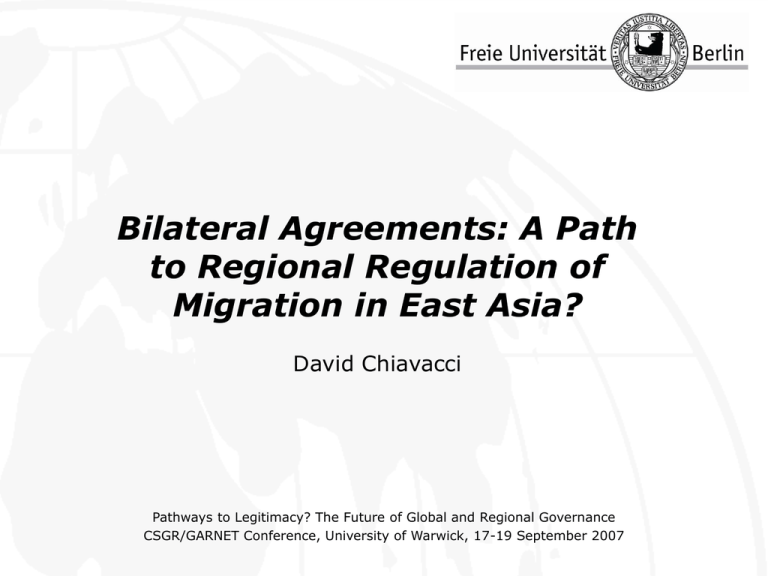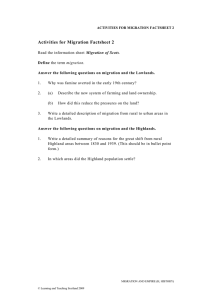Bilateral Agreements: A Path to Regional Regulation of Migration in East Asia?
advertisement

Bilateral Agreements: A Path to Regional Regulation of Migration in East Asia? David Chiavacci Pathways to Legitimacy? The Future of Global and Regional Governance CSGR/GARNET Conference, University of Warwick, 17-19 September 2007 Introduction • Since late 1980s, East Asia established as migration region and increasingly migration movements • Repeatedly calls for stronger regional cooperation concerning migration in East Asia • New multilateral forums, but enforceable multilateral agreement or regional regime for non-highly skilled workers very difficult • New bilateral agreements a good alternative or even a path to regional regulation of migration? Overview 1. East Asian Migration Region: Emergence and Patterns 2. Multilateral Regional Migration Forums 3. Bilateral Agreements in East Asia as Path to Regional Regulation? 4. Concluding Remarks Emergence of the East Asian Migration Region • 1945 to 1970s: East Asia a non-migration region • 1970s onwards, emigration to Anglo-Saxon immigration countries of New World and oil-exporting countries of Golf region • Early 1980s onwards, increasingly intraregional migration flows • Late 1980s, establishment of East Asian migration region Regional Origin of Asian Foreign Workers in Asia, late 1990s (in thousands) Gulf Cooperation Council Malaysia Thailand Singapore Hong Kong Japan Taiwan South Korea Brunei West Malaysia East Malaysia 0 300 600 900 South Asia Source: Own Calculations based on Stahl (2003: 36-37). 1200 1500 East Asia 1800 2100 Patterns of the East Asian Migration Region • Very defensive policy approach • • Unilateral migration policy Neither multicultural integration nor assimilation, but exclusion of foreign immigrants • Crucial role of private migration industry in regional migration movements • Intraregional differences • • Advanced economies with relative strict enforcement Semi-peripheral economies with relative loose enforcement Need for Stronger Regional Cooperation • Problems • • • • • Political tensions due to migration issues • • Large number and share of undocumented foreign workers Exploitation of foreign workers Human rights infractions Human trafficking, debt-bounded migration E.g. between Philippines and Malaysia Recurring calls for stronger regional cooperation regarding international migration Overview 1. East Asian Migration Region: Emergence and Patterns 2. Multilateral Regional Migration Forums 3. Bilateral Agreements in East Asia as Path to Regional Regulation? 4. Concluding Remarks New Multilateral Initiatives • Manila Process (established 1996) • Irregular migration and trafficking in persons • 1999 Bangkok Declaration • Inter-Governmental Asia-Pacific Consultations on Refugees, Displaced Persons and Migrants (APC, established 1996) • Bali Process (established 2002) • People smuggling, trafficking in persons and related transnational crime • ASEAN • 2007 ASEAN Declaration on the Protection and Promotion of the Rights of Migrant Workers Strength and Deficits of Multilateral Initiatives in East Asia • Important forums for information sharing and dialogue among governments • Increased understanding and consciousness of migration issues • No binding agreements, no overlooking institution • Enforcement of even very general declarations not granted • Specific migration issues discussed, but not general dialogue on migration issues or migration and economic development • What is achievable in view of large number of participating economies and economic differences? Overview 1. East Asian Migration Region: Emergence and Patterns 2. Multilateral Regional Migration Forums 3. Bilateral Agreements in East Asia as Path to Regional Regulation? 4. Concluding Remarks FTA-Stampede in East Asia • Strong increase of bilateral trade agreements in East Asia (FTA-stampede) • Negative, pessimistic view • • • • Positive trade discrimination Noodle bowl because of rule of origins Increasing rivalry between PR China, Japan and South Korea Positive, optimistic view • • Important first step for an East Asian free trade area Increasing number of bilateral agreements concerning migration a step towards regional regulation? Reached Bilateral Agreements concerning Migration in East Asia • Types of agreements • Memoranda of Understanding (MOU): “soft approach”, very broad framework • Bilateral Agreements (BA): more specific, formal and binding • Malaysia and Thailand: a number of MOUs with countries of origin • South Korea: 6 MOUs under Employment Permit System (Indonesia, Mongolia, Philippines, Sri Lanka, Thailand and Vietnam) • Taiwan: BAs (Thailand and Vietnam) and MOUs (Indonesia and Philippines) • Japan: Economic Partnership Agreements (Philippines, Thailand and Indonesia) A Step Forward? • Positive, optimistic view • • • • • Migration flows primarily bilateral and not regional (especially flows of non-highly skilled workers) Possibility of specific solutions for bilateral problems Migration as general issue addressed Positive discrimination, but binding regional agreement in view of economic and demographic gaps for the time being realistic? Negative, pessimistic view • • • • “Soft” MOUs really a step forward? Some provisions in agreements do not conform to international norms and good practice on protection of migrant rights Migration in agreements very rarely linked to other economic issues Monitoring and enforcement of MOUs and BAs (especially concerning foreign worker protection) Northeast Asian Economies as Regional Leaders? • Taiwan • Foreign guest worker program since 1989 • Background: impede undocumented migration from PR China and hollowing-out of industry to PR China • South Korea • Foreign trainee program • 2004, introduction of guest worker program • Initial quotas very low • Japan • Foreign trainee program • EPAs with Philippines, Thailand and Indonesia including migration clauses (strong linkage) • Initial quotas very low • Non-highly skilled workers? Driving and Retarding Factors for a Less Unilateral Immigration Policy • Driving factors • • • • • • Security and internal order Labor shortage (also in not exportable economic sectors) Economic gains Improvement of international status Regional leadership aspiration Retarding factors • • • • • • Nationalism (mono-ethnic states) Ability to control national border European guest worker programs generally regarded as failure Regional oversupply of non-highly skilled labor Potential size of flows due to demographic and economic gaps Size of PR China and Indonesia East Asia and Emigration Trap Size of emigration flow of non-highly skilled workers Emigration trap Development of Philippines European experience Economic development Overview 1. East Asian Migration Region: Emergence and Patterns 2. Multilateral Regional Migration Forums 3. Bilateral Agreements in East Asia as Path to Regional Regulation? 4. Concluding Remarks East Asia and Migration • Paradoxes of migration in East Asia • Economic gains, but politically problematic • Regional regulation needed because of potential migration movements, but very difficult because of potential migration movements • MOUs and BAs as alternative or even path to regional regulation? • Very difficult • Still, development only at the beginning and at least important supplement to regional forums • FTA/EPA between PR China and Japan including migration clauses? • Migration not a driving force for regional integration; stronger regional institutions precondition for regional regulation of migrations






